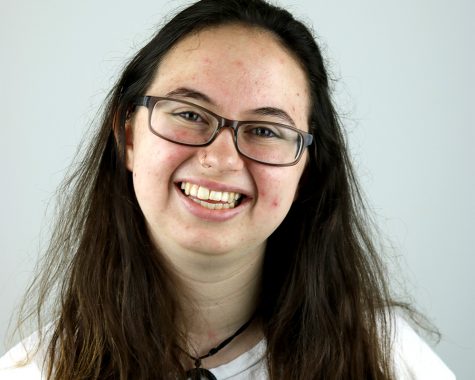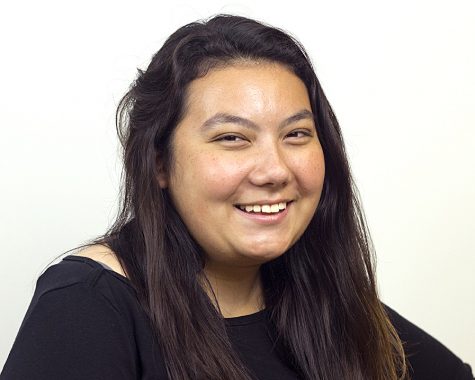Several departments discuss the future transition to new College of Liberal Arts and Sciences
April 12, 2018
The combination of the College of Arts and Humanities with the College of Sciences has departments in it talking about how they will collaborate and transition into one entity.
In the reorganization plan recently announced by Provost Jay Gatrell, the College of Liberal Arts and Sciences would be the biggest of the four colleges.
In it would be two schools, (the School of Fine and Performing Arts and the School of Communication and Journalism) as well as the history, philosophy, foreign language, English, political science, economics, psychology, biology, physics, geology/geography, math and computer science, sociology, anthropology and criminology and chemistry departments.
Gatrell plans to have the college combination implemented by July 1. However, he has said the coming academic year is a “process” where things can be tweaked if needed.
“It’s a year of transition,” Gatrell said. “(It) requires shared governance, open and frank discussions.”
The current operating budgets for all four colleges are $75,000 each for a total of $300,000. Future budgets will be based on the total number of faculty in the college, Gatrell said.
“One of the reasons we’re talking about adjusting budgets (is that we’re) making sure resources are there for every faculty member in every program to thrive,” Gatrell said.
The existing resources for academic departments themselves will not be impacted. The only thing that would become a question of redistribution or reallocation would be how the dean’s office is funded, according to Gatrell.
The dean of the College of Liberal Arts and Sciences’ office is set to be in Doudna. Two associate deans will correspond to the College of Arts and Humanities and the College of Sciences.
Doug Klarup, the dean of the College of Sciences, said hurdles to the plan will come in the form of the administrative details being worked out.
“Although (the College of Arts and Humanities and the College of Sciences) have a lot of similarities, they come with different procedures and that’s going to have to be sorted out,” Klarup said.
Anita Shelton, dean of College of Arts and Humanities, said the college is still in a bit of a holding pattern until the Board of Trustees approves the reorganization, though she and the dean of the College of Sciences have been communicating.
Because they are anticipating the board’s approval, the deans are planning in May to start joint meetings with deans and chairs in both of the colleges.
One issue to be looked at is making sure there is sufficient staff in place for the new dean’s office. The provost has said no staff positions will be eliminated, but some will be reassigned to support academic departments, registrar and the new College of Health and Human Services.
As dean, Shelton said she wants to make sure the support staff is not overloaded with work as a result of the colleges combining.
“There’s a lot of work that has to be done,” Shelton said. “There’s Doudna to run, the Tarble Arts Center, in this college now we’re adding another nine or so departments from sciences—it increases the workload a lot.”
Collaboration between different disciplines will become easier in the new college, especially when it comes to ongoing initiatives such as the ones in health communications and the medical humanities, she said. Shelton said whoever the dean is will have to learn about the discipline they are not already familiar with.
“It’s definitely a process of adjusting and adapting, but I think that the physical spaces remaining for the most part the same is going to help with maintaining the cultures that people are accustomed to,” Shelton said.
Steven Daniels, chair of the physics department, and Diane Burns, chair of the geology/geography department, both have backgrounds in schools that had a liberal arts and science-based college.
“I really am used to the whole concept,” Daniels said. “I think the sciences and humanities are tied together.”
Burns said in a lot of respects, it is a natural pairing.
Marshall Lassak, chair of the math and computer science department, said if the university is going to reorganize, having a College of Liberal Arts and Sciences is not uncommon.
“(It’s) always a concern that whoever the dean is, will (they) be able to adequately sort of address all the areas, but it’s not an impossible thing to do,” Lassak said.
Programmatic things might be made easier and the colleges will see each other more often, Daniels said.
The biggest issue Daniels has heard about the reorganization is how fast it is, but Daniels said these things have already been thought about during the vitalization project.
“It’s good we’re moving on (with) real substantive changes that will improve the university,” he said.
25 years ago, Eastern had a structure like the one Gatrell proposed, political science chair Richard Wandling said.
“In a sense, we’re going back and we’re bringing back a model that’s time-tested,” Wandling said.
Wandling said with such a big college, there could be a risk of losing smaller programs in the transition process, though this would be the case no matter what the organizational scheme would be.
“There are going to be some inherently large departments in that college, for example biological sciences, communications studies, psychology,” Wandling said. “On the other hand, to the extent that it facilitates ongoing partnerships with a more moderate-sized department, then I think it could also be a plus for those departments.”
Seeing how one bigger college will work into the structure of the university might be difficult, Daniels said, but he thinks it will work.
“It depends on the leadership,” he said.
Though the college will be large, Burns said this does not necessarily mean it will be detrimental.
“As long as it’s still the same playing field, all the chairs get together to talk, all the chairs hear each other and all the deans get together to talk and all the deans hear one another, I don’t think there’s going to be any burying of any voices,” she said.
History department chair Nora Small said this change is an important evolution for Eastern.
“The entire plan strikes me as very forward looking, and EIU in its 100+ years of existence has gone through many identities, from a normal school to a university,” Small said. “It strikes me that this is another part of that continuing tradition of changing with the times.”
Philosophy chair Jonelle DePetro said she is enthusiastic about the proposed changes.
“(Changes) can be a little mysterious, what will the changes actually be or mean in terms of committee structure and how things get done, but I imagine we’ll find our way,” DePetro said. “There will be a few bumps and then it’ll be just fine.”
Economics chair Ali Moshtagh said he is excited to move past the mentality of the last couple of years.
“(Eastern) needs to get over this vicious rumor that was spread all over the state that Eastern is going to close,” Moshtagh said. “By doing this (restructuring), we’re sending a strong message to the whole state that Eastern is not going to close, Eastern is a viable institution of higher learning.”
Cassie Buchman and Brooke Schwartz can be reached at 581-2812 or [email protected].




















































